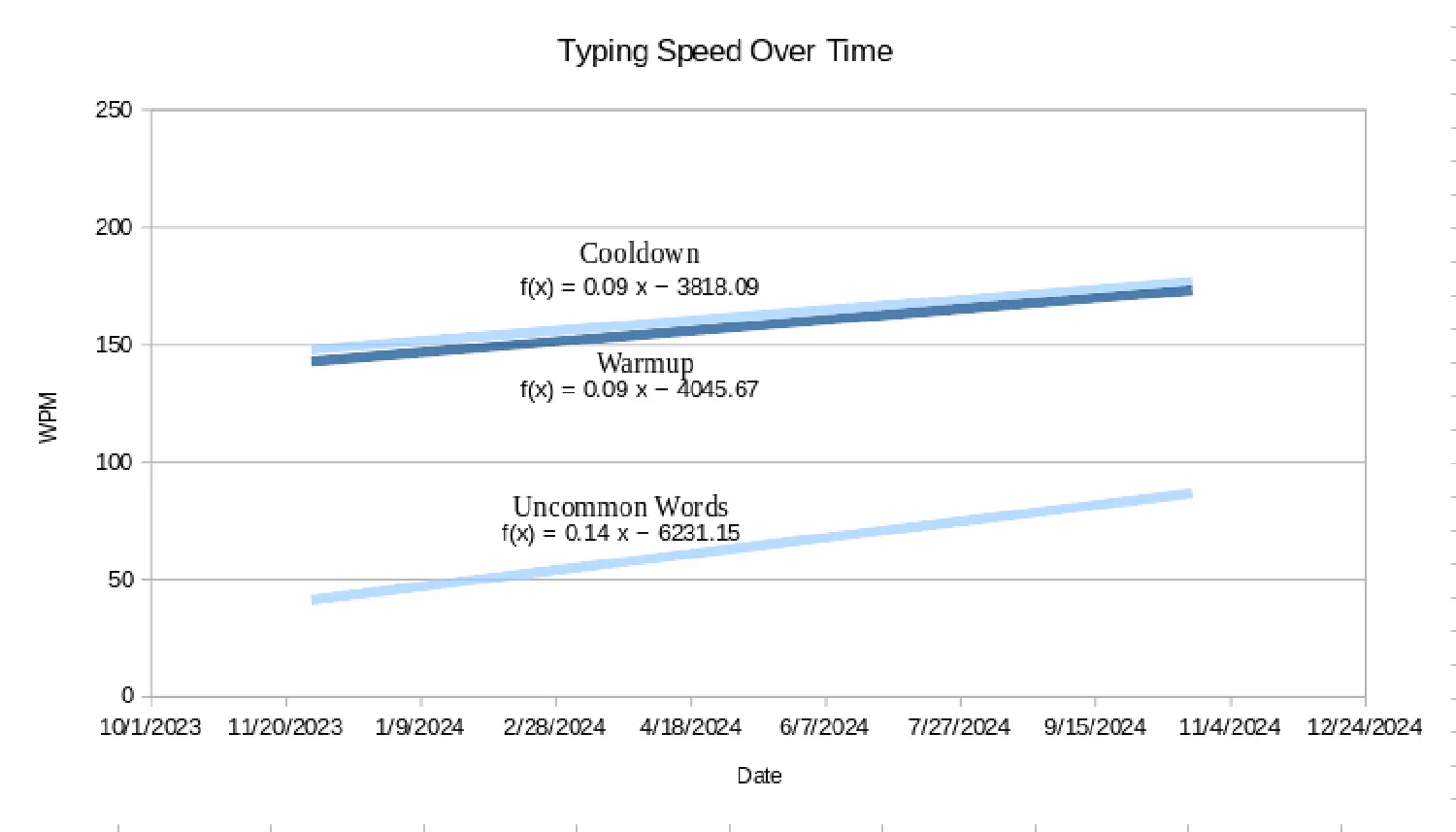One Year of Stenography Data

Overview
October 21st, 2024, is a special day for me because it marks the one year anniversary of tracking my progress of typing using a stenograph. While I started learning the system in January of 2023, I never recorded more than an occasional “new record” speed until October. Every day, I practice stenography (steno) for 1 hour, recording the best speeds I achieved across multiple typing categories. Tracking this data has been one of the most beneficial practices for improving my typing speed and has allowed for some very cool representations of my progress.
Improvements
Over this past year, my typing speed has improved as follows:
| Category | Common Words (Top 75%) | Uncommon Words (75% - 92%) | Natural Language |
|---|---|---|---|
| Oct. 2023 | 135 WPM | 40 WPM | 105 WPM |
| Oct. 2024 | 175 WPM | 85 WPM | 155 WPM |
Overall, I am very happy with my improvements and plan to continue this trend throughout the next year. I spent the first third of this year focusing on getting common words above 150 WPM and the next two thirds trying to get uncommon words above 100 WPM. There was no time limit for any of these goals, and the second was especially ambitious, as it required a 150% increase in my typing speed. That is an insane goal for any typing system, but I need to get used to it, as my overall stenography goal is 240 WPM with Natural Language.
Data Analyses
Collecting this data also set up some very cool visualizations for my typing speed over time. For example, I assumed linear growth and assigned a trendline to each category of typing. The slope of this line tells me the average amount my typing speed improved each day: 0.095 WPM/day for common words and 0.14 WPM/day for uncommon words. This may not seem like a lot, but that equates to about 1 WPM improvement per week, which stacks up very quickly.
I also created a pivot table to see what time of day I type fastest. Excluding edge cases (the one time I did my stenography practice at 3:00 AM, etc.), I type fastest at 6:00 PM and slowest at 12:00 PM (with about a 10-15 WPM difference in all categories). I also found that my cooldown speed was consistently higher than my warmup speed by about 5 WPM. The peaks and vallies of the graphs also consistently lined up, supporting the idea of having “good days” and “bad days” where I type faster or slower in all categories without any apparent cause.
There was also weak or zero correlation between the keyboard I used and my typing speed. I recorded my current location for each stenography practice session and noted that I use my travel keyboard instead of my regular keyboard when away from my living space. There was about a 2 WPM difference in each category between the keyboard types, but this difference can also be attributed to the fact that I practiced on my regular keyboard more often near the end of the year, which natrually would have a higher typing speed due to normal improvement. My travel keyboard also uses 20g springs, compared to my regular keyboard’s 35g springs, supporting a surprising and controversial argument that lighter springs do not actually improve stenography typing speed.
There are so many more analyses I can make on the data, so if you have one you want to see, let me know! You can download the data if you want to make and share your own interpretation too.
Next Steps
What’s next? Keep practicing. Keep improving. Keep pushing myself beyond what I thought was possible just one year ago. I’m still on my journey to 240 WPM and am a hair’s width away from hitting 200 WPM for common words. I’m staying in the “chapter” of practice centered around uncommon words until I can consistently reach my goal of 100 WPM, and I plan to work on natural language briefs for the next section.
Download the Data
Click here to download a copy of the data! Location data is not provided for privacy reasons. If you want more information or have interesting analyses of the data, shoot me an email at coopershapard(AT)duck.com! (The @ was removed to prevent bot scraping).
